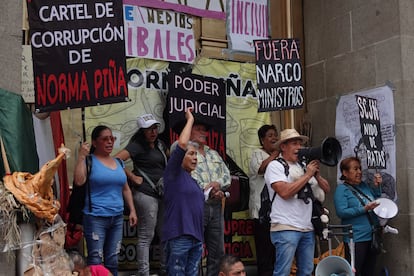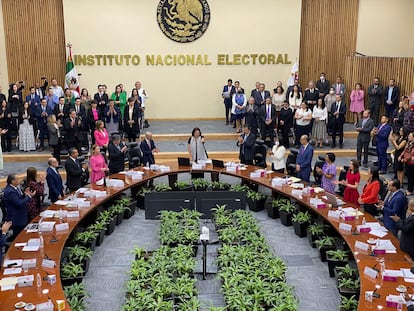Clashes between President López Obrador and Supreme Court bog down Mexican politics
The number of disputes over laws and decrees between the executive branch and the judiciary has skyrocketed during AMLO’s six-year term, straining the institutional balance in Mexico


The disagreements between the judiciary and the executive branch in Mexico have been one of the constants of political life since President Andrés Manuel López Obrador (popularly known as AMLO) began his six-year term. This past week, the president – once again – railed against the members of his country’s Supreme Court. This time, he is using the argument of fiscal responsibility, asking why these jurists earn such high salaries.
Some political analysts have accused the president of violating governmental norms in his disputes with the Supreme Court. They say that not agreeing with the judiciary’s rulings is no reason for insults, such as those that the president launches every morning against the justices on his televised conferences. Others, however, accept that the logic that a struggle between the two branches is a normal occurrence in the strongest democracies. Still, the escalation of polarization takes a toll on institutionality.
The numbers speak of an excessive judicialization of politics in AMLO’s six-year term, with 809 constitutional controversies having been debated, with 572 rulings of unconstitutionality. During President Vicente’s Fox’s term (2000-2006), only 414 laws and decrees were debated – the second-highest amount.
“The many [executive] decrees… are the reason for these figures. Also the bills that have passed through the Supreme Court,” explains Laura Valencia – a political scientist at Metropolitan Autonomous University (UAM) in Mexico City – who provided the data.
With no absolute majority in the Congress, AMLO’s administration has taken shortcuts to carry out its policies. However, a good part of these executive decisions have later collided with courts. The opposition parties have often resorted to filing legal complaints, aware that the executive branch tends to legislate near the edge of the law. “This judicialization of politics drags on,” says Valencia, who believes that the absence of a political majority generates a constant struggle with the judicial branch – one that affects the balance of powers.
This past week, AMLO criticized members of the court who earn more than the president’s salary, something that is unconstitutional. He earns 137,000 pesos each month (around $8,000) compared to 284,500 pesos each month (around $16,500) per justice, according to publicly-available official data. Law professor Julio Ríos acknowledges that this difference not only exists, but also that the salary of Mexican Supreme Court justices is above the average of their colleagues in other Latin American countries, as demonstrated in a comparative study put together by Ana Laura Magaloni and Carlos Elizondo. “Not that that’s bad, but it is a bit high,” Ríos notes. “Of course, they don’t all earn the same [wage]... it depends on [when] they entered the court,” warns this researcher from Mexico’s Autonomous Institute of Technology (ITAM). He’s aware that there’s still much to improve in the judiciary, but that the institution “cannot give way to insults.”
“It seems to me that the government, in reality, doesn’t have a legitimate interest in fixing what may be wrong with the Supreme Court. Rather, its objective is the cooptation, subordination and erosion of institutional controls,” Ríos opines. “The [president’s] proposal for a direct vote to appoint [members of the court] is just another battering ram, he doesn’t even present it in a serious way.”
For this legal scholar, one of the strongest signs of interference made by the executive into the judiciary was when Justice Medina-Mora resigned in October of 2019, when he still had 11 years out of his 15-year-term left on the bench. In Ríos’s opinion, this was a “forced exit… [Medina-Mora] was harassed by the Financial Intelligence Unit. The day after his resignation, his accounts were unfrozen.”
Ríos is part of a group of jurists and legal experts that, for years, has been pointing out the nepotism that exists in the judiciary. “But since 2018, there has been an appropriation of criticism by the government. This is somewhat right… but when making the argument that resources can be used in a better way, insults cannot be tolerated,” he emphasizes.
When Norma Piña became president of the Supreme Court this past January, a Pandora’s box opened up. The president had failed to place Yasmín Esquivel – his trusted ally – in that position, as her aspirations sank after it was alleged that she had plagiarized her undergraduate thesis. However, among jurists, there was a sense of relief following Piña’s first statements, in which she defended the autonomy of the courts.
The tension between the executive and the judiciary hasn’t abated. “The president passes laws that are unconstitutional and [then] throws the ball into the court of the Supreme Court. If they let it pass, they commit institutional suicide… and if they choose to put a stop to it, they get insults and threats,” Ríos summarizes. “The work of the judge isn’t questioned, but the individual is attacked by name.” He is of the opinion that a president “who has legal and legitimate authority” cannot single out certain people, “as he did recently [following the arrest of a judge in Veracruz]. He’s questioning the basic rules in a highly aggressive manner that goes beyond normal friction.”
How this affects the institutional or democratic health of the country is something that political scientist Alfonso Pérez places more in the field of forms rather than substance. He believes that Mexico is already accustomed to an increasingly consolidated division of powers, which began in 1997. This has been demonstrated by notorious cases, such as that of French citizen Florence Cassez, who was released from custody by the Supreme Court and repatriated to France in 2013, after irregularities were found in her 2005 conviction for kidnapping.
“When López Obrador won, it was expected that things would continue in that direction, but no, the processes are beginning to be reversed,” the legal scholar laments. The tensions that are being exacerbated today between the two institutions have to do, he says, with the autonomy that the judiciary has gained over the years. This has caused the president to experience some setbacks in the legislative measures he wishes to take. Ríos believes that “good judgment” now prevails among those who make up the Supreme Court.
That being said, judges are also politicized and ideological people – their rulings can divide society. For instance, the same week that AMLO clashed with the courts in his country, the US Supreme Court effectively struck down affirmative action for minority students in higher education. This ruling has generated much criticism and debate. Judges may not always be correct in their resolutions, nor can it be said that they’re free from ideological bias. So, what’s wrong with the verbal attacks made by the Mexican president?
“It’s valid to dissent from the decisions of the Supreme Court, but another thing is when the attacks come from the executive branch or the legislature. While this happens in every country, since the appointment of Norma Piña, in Mexico, the attacks are becoming a narrative,” warns Franisco Burgoa, a professor of Constitutional Law at the National Autonomous University of Mexico (UNAM). “This has to stop for the sake of institutional democracy.”
For Burgoa, a sign of faltering institutional health is a recent statement that was made by López Obrador, in which he said that he had met with five of the 11 justices of the Supreme Court, in an attempt to convince them to rule in his favor to put the civilian-lead National Guard under military control – one of the most controversial measures he has taken over the course of his six-year term. “He believes that [the judges] are his subordinates – that’s disrespecting the autonomy and independence of the court,” Burgoa affirms.
Julio Ríos uses a soccer analogy to define the natural tensions at play between the two powers: “Everyone on the pitch knows that there will be pushing, shouting and passion… but no one questions that you can’t score a goal with your hand, or that there should be 11 players on the pitch.”
Sign up for our weekly newsletter to get more English-language news coverage from EL PAÍS USA Edition
Tu suscripción se está usando en otro dispositivo
¿Quieres añadir otro usuario a tu suscripción?
Si continúas leyendo en este dispositivo, no se podrá leer en el otro.
FlechaTu suscripción se está usando en otro dispositivo y solo puedes acceder a EL PAÍS desde un dispositivo a la vez.
Si quieres compartir tu cuenta, cambia tu suscripción a la modalidad Premium, así podrás añadir otro usuario. Cada uno accederá con su propia cuenta de email, lo que os permitirá personalizar vuestra experiencia en EL PAÍS.
¿Tienes una suscripción de empresa? Accede aquí para contratar más cuentas.
En el caso de no saber quién está usando tu cuenta, te recomendamos cambiar tu contraseña aquí.
Si decides continuar compartiendo tu cuenta, este mensaje se mostrará en tu dispositivo y en el de la otra persona que está usando tu cuenta de forma indefinida, afectando a tu experiencia de lectura. Puedes consultar aquí los términos y condiciones de la suscripción digital.
More information
Archived In
Últimas noticias
There is as much life left to discover on planet Earth as that which is already known
Dozens presumed dead, around 100 injured in fire at Swiss Alps bar during New Year’s celebration
Is porn for women different from conventional porn? We spoke to those who make it
Cartagena de Indias is sinking: What can the city do to mitigate it?
Most viewed
- Reinhard Genzel, Nobel laureate in physics: ‘One-minute videos will never give you the truth’
- Sinaloa Cartel war is taking its toll on Los Chapitos
- David King, chemist: ‘There are scientists studying how to cool the planet; nobody should stop these experiments from happening’
- Oona Chaplin: ‘I told James Cameron that I was living in a treehouse and starting a permaculture project with a friend’
- The Interoceanic Train, the Mexican alternative to the Panama Canal










































